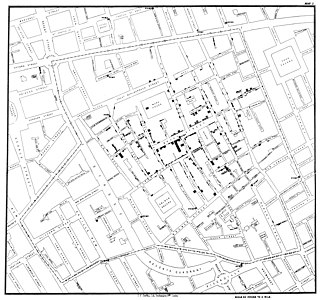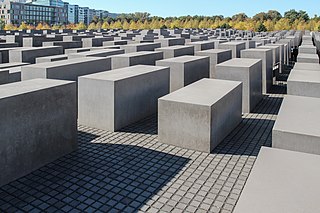Related Research Articles

Human geography or anthropogeography is the branch of geography that is associated and deals with humans and their relationships with communities, cultures, economies, and interactions with the environment by studying their relations with and across locations. It analyzes patterns of human social interaction, their interactions with the environment, and their spatial interdependencies by application of qualitative and quantitative research methods.

Economic geography is the subfield of human geography which studies economic activity and factors affecting them. It can also be considered a subfield or method in economics. There are four branches of economic geography. There is, primary sector, Secondary sector, Tertiary sector, & Quaternary sector.

In urban planning, architecture and civil engineering, the term built environment, or built world, refers to the human-made environment that provides the setting for human activity, including homes, buildings, zoning, streets, sidewalks, open spaces, transportation options, and more. It is defined as "the human-made space in which people live, work and recreate on a day-to-day basis."

Urban geography is the subdiscipline of geography that derives from a study of cities and urban processes. Urban geographers and urbanists examine various aspects of urban life and the built environment. Scholars, activists, and the public have participated in, studied, and critiqued flows of economic and natural resources, human and non-human bodies, patterns of development and infrastructure, political and institutional activities, governance, decay and renewal, and notions of socio-spatial inclusions, exclusions, and everyday life.

In cognitive psychology and neuroscience, spatial memory is a form of memory responsible for the recording and recovery of information needed to plan a course to a location and to recall the location of an object or the occurrence of an event. Spatial memory is necessary for orientation in space. Spatial memory can also be divided into egocentric and allocentric spatial memory. A person's spatial memory is required to navigate around a familiar city. A rat's spatial memory is needed to learn the location of food at the end of a maze. In both humans and animals, spatial memories are summarized as a cognitive map.

A place cell is a kind of pyramidal neuron within the hippocampus that becomes active when an animal enters a particular place in its environment, which is known as the place field. Place cells are thought, collectively, to act as a cognitive representation of a specific location in space, known as a cognitive map. Place cells work with other types of neurons in the hippocampus and surrounding regions to perform this kind of spatial processing. They have been found in a variety of animals, including rodents, bats, monkeys and humans.

A cognitive map is a type of mental representation which serves an individual to acquire, code, store, recall, and decode information about the relative locations and attributes of phenomena in their everyday or metaphorical spatial environment. The concept was introduced by Edward Tolman in 1948. The concept was used to explain the behavior of rats that appeared to learn the spatial layout of a maze, and subsequently the concept was applied to other animals, including humans. The term was later generalized by some researchers, especially in the field of operations research, to refer to a kind of semantic network representing an individual's personal knowledge or schemas.

Environmental psychology is an interdisciplinary field that focuses on the transactions between individuals and their surroundings. It examines the way in which the natural environment and our built environments shape us as individuals. Environmental Psychology emphasises how humans change the environment and how the environment changes humans experiences and behaviors. The field defines the term environment broadly, encompassing natural environments, social settings, built environments, learning environments, and informational environments.

A spatial network is a graph in which the vertices or edges are spatial elements associated with geometric objects, i.e., the nodes are located in a space equipped with a certain metric. The simplest mathematical realization of spatial network is a lattice or a random geometric graph, where nodes are distributed uniformly at random over a two-dimensional plane; a pair of nodes are connected if the Euclidean distance is smaller than a given neighborhood radius. Transportation and mobility networks, Internet, mobile phone networks, power grids, social and contact networks and biological neural networks are all examples where the underlying space is relevant and where the graph's topology alone does not contain all the information. Characterizing and understanding the structure, resilience and the evolution of spatial networks is crucial for many different fields ranging from urbanism to epidemiology.
Behavioral geography is an approach to human geography that examines human behavior using a disaggregate approach. Behavioral geographers focus on the cognitive processes underlying spatial reasoning, decision making, and behavior. In addition, behavioral geography is an ideology/approach in human geography that makes use of the methods and assumptions of behaviorism to determine the cognitive processes involved in an individual's perception of or response and reaction to their environment.
In sociology and organizational studies, institutional theory is a theory on the deeper and more resilient aspects of social structure. It considers the processes by which structures, including schemes, rules, norms, and routines, become established as authoritative guidelines for social behavior. Different components of institutional theory explain how these elements are created, diffused, adopted, and adapted over space and time; and how they fall into decline and disuse.

Spatial analysis or spatial statistics includes any of the formal techniques which studies entities using their topological, geometric, or geographic properties. Spatial analysis includes a variety of techniques, many still in their early development, using different analytic approaches and applied in fields as diverse as astronomy, with its studies of the placement of galaxies in the cosmos, to chip fabrication engineering, with its use of "place and route" algorithms to build complex wiring structures. In a more restricted sense, spatial analysis is the technique applied to structures at the human scale, most notably in the analysis of geographic data or transcriptomics data.
A community of place or place-based community is a community of people who are bound together because of where they reside, work, visit or otherwise spend a continuous portion of their time. Such a community can be a neighborhood, town, coffeehouse, workplace, gathering place, public space or any other geographically specific place that a number of people share, have in common or visit frequently. A community offers many appealing features of a broader social relationship: Safety, familiarity, support and loyalties as well as appreciation. Appreciation that is founded on efforts and contribution to the community, rather than the efforts, rank or status of an individual.
In behavioral geography, a mental map is a person's point-of-view perception of their area of interaction. Although this kind of subject matter would seem most likely to be studied by fields in the social sciences, this particular subject is most often studied by modern-day geographers. They study it to determine subjective qualities from the public such as personal preference and practical uses of geography like driving directions.
Integrative neuroscience is the study of neuroscience that works to unify functional organization data to better understand complex structures and behaviors. The relationship between structure and function, and how the regions and functions connect to each other. Different parts of the brain carrying out different tasks, interconnecting to come together allowing complex behavior. Integrative neuroscience works to fill gaps in knowledge that can largely be accomplished with data sharing, to create understanding of systems, currently being applied to simulation neuroscience: Computer Modeling of the brain that integrates functional groups together.

The sociology of space is a sub-discipline of sociology that mostly borrows from theories developed within the discipline of geography, including the sub fields of human geography, economic geography, and feminist geography. The "sociology" of space examines the social and material constitution of spaces. It is concerned with understanding the social practices, institutional forces, and material complexity of how humans and spaces interact. The sociology of space is an inter-disciplinary area of study, drawing on various theoretical traditions including Marxism, postcolonialism, and Science and Technology Studies, and overlaps and encompasses theorists with various academic disciplines such as geography and architecture. Edward T. Hall developed the study of Proxemics which concentrates on the empirical analysis of space in psychology.

The following outline is provided as an overview of and topical guide to geography:
Social network analysis in criminology views social relationships in terms of network theory, consisting of nodes and ties These networks are often depicted in a social network diagram, where nodes are represented as points and ties are represented as lines.

Cognitive geography is an interdisciplinary study of cognitive science and geography. It aims to understand how humans view space, place, and environment. It involves the formalization of factors that influence our spatial cognition to create a more effective representation of space. These improved models assist in a variety of issues, for example, the developing maps that communicate better, providing navigation instructions that are easier to follow, utilizing space more practically, accounting for the cultural differences on spatial thinking for more effective cross-cultural information exchange, and an overall increased understanding of our environment.

Spatial ability or visuo-spatial ability is the capacity to understand, reason, and remember the spatial relations among objects or space.
References
- ↑ Cagney, Kathleen A.; York Cornwell, Erin; Goldman, Alyssa W.; Cai, Liang (2020-07-30). "Urban Mobility and Activity Space". Annual Review of Sociology. 46 (1): 623–648. doi:10.1146/annurev-soc-121919-054848. ISSN 0360-0572.
- ↑ Anderson, J (1971-12-01). "Space-Time Budgets and Activity Studies in Urban Geography and Planning". Environment and Planning A: Economy and Space. 3 (4): 353–368. doi:10.1068/a030353. ISSN 0308-518X.
- 1 2 3 Horton, Frank E.; Reynolds, David R. (1971). "Effects of Urban Spatial Structure on Individual Behavior". Economic Geography. 47 (1): 36–48. doi:10.2307/143224. ISSN 0013-0095.
- ↑ Brown, Lawrence A.; Moore, Eric G. (1970-04-01). "The Intra-Urban Migration Process: a Perspective". Geografiska Annaler: Series B, Human Geography. 52 (1): 1–13. doi:10.1080/04353684.1970.11879340. ISSN 0435-3684.
- ↑ Gould, Peter; White, Rodney (2004-01-10). Mental Maps (2 ed.). London: Routledge. doi:10.4324/9780203111512/mental-maps-pet. ISBN 978-0-203-11151-2.
- ↑ Tolman, Edward C. (1948). "Cognitive maps in rats and men". Psychological Review. 55 (4): 189–208. doi:10.1037/h0061626. ISSN 1939-1471.